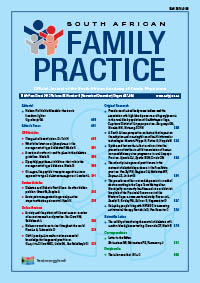Prevalence of raised body mass indices and the association with high blood pressure and hyperglycaemia in the rural black population of Ga-Mothapo village, Capricorn District of Limpopo province
Keywords:
Overweight, obesity, high blood pressure, hyperglycaemia, rural black population
Abstract
Objective: To assess the prevalence of elevated body mass index and to establish whether there was an association between raised body mass index (BMI) and high blood pressure (BP) and hyperglycaemia in the rural population of Ga-Mothapo village, Limpopo province. Design: Cross-sectional and prospective in nature. Setting: Ga-Mothapo village, a rural settlement with a population of 11 000, situated in the Capricorn region of Limpopo province, approximately 28 km east of Polokwane. Subjects: The study sample comprised 382 participants, of whom 286 were females (74.9%) and 96 males (25.1%), aged 18-65 years. Outcome measures: Fasting blood glucose samples were analysed using the ILab 300 Plus®. BP pressure was measured using an automatic BP monitor. Height and weight were measured using a height-measuring rod and weighing scale, respectively. The BMI was calculated. Results: The overall prevalence rates of overweight, obesity, high BP and hyperglycaemia were 30.6%, 23.6%, 27% and 11.8%, respectively. The prevalence rates of overweight, obesity, high BP and hyperglycaemia in females were 34.6%, 29.4%, 27.3% and 13.6% respectively. They were 18%, 6.3%, 26.1% and 6.3%, in the males, respectively. Conclusion: The study revealed high prevalence rates of raised BMI, high BP and hyperglycaemia in the Ga-Mothapo population. Females had higher prevalence rates of raised BMI and hyperglycaemia than males. The study highlighted the fact that raised BMI and hyperglycaemia were significantly associated with high BP.
Published
2013-04-16
Section
Original Research
By submitting manuscripts to SAFP, authors of original articles are assigning copyright to the South African Academy of Family Physicians. Copyright of review articles are assigned to the Publisher, Medpharm Publications (Pty) Ltd, unless otherwise specified. Authors may use their own work after publication without written permission, provided they acknowledge the original source. Individuals and academic institutions may freely copy and distribute articles published in SAFP for educational and research purposes without obtaining permission.

